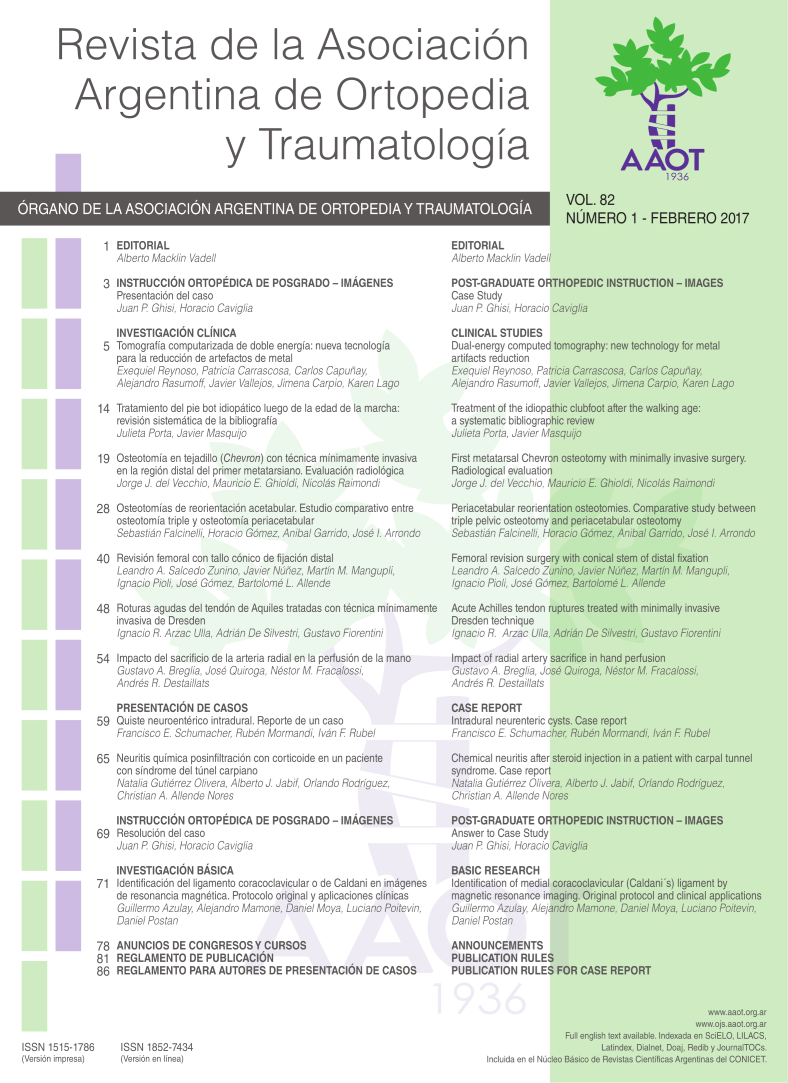Identification of medial coraco-clavicular (Caldani's) ligament by magnetic resonance imaging. Original procedure and clinical applications.
Main Article Content
Abstract
Downloads
Metrics
Article Details

This work is licensed under a Creative Commons Attribution-NonCommercial-ShareAlike 4.0 International License.
Manuscript acceptance by the Journal implies the simultaneous non-submission to any other journal or publishing house. The RAAOT is under the Licencia Creative Commnos Atribución-NoComercial-Compartir Obras Derivadas Igual 4.0 Internacional (CC-BY-NC.SA 4.0) (http://creativecommons.org/licences/by-nc-sa/4.0/deed.es). Articles can be shared, copied, distributed, modified, altered, transformed into a derivative work, executed and publicly communicated, provided a) the authors and the original publication (Journal, Publisher and URL) are mentioned, b) they are not used for commercial purposes, c) the same terms of the license are maintained.
In the event that the manuscript is approved for its next publication, the authors retain the copyright and will assign to the journal the rights of publication, edition, reproduction, distribution, exhibition and communication at a national and international level in the different databases. data, repositories and portals.
It is hereby stated that the mentioned manuscript has not been published and that it is not being printed in any other national or foreign journal.
The authors hereby accept the necessary modifications, suggested by the reviewers, in order to adapt the manuscript to the style and publication rules of this Journal.
References
2. Rouvière H. Anatomie Humaine Descriptive et Topographique, Masson, Paris; 1927 (2). p.36.
3. StedmanT L. A practical medical dictionary, New York, W. Wood and company; 1920. P. 153.
4. Poitevin L, Postan D. Moya, D, Valente S, Azulay G.; Mamone A, Giacomelli Anatomía del Ligamento Córaco-clavicular Medial. Primera Parte: Investigación Anatómica.. Rev. Arg. Anat. Onl.2014, Vol. 5, Nº 4: 119 – 126.
5. Vallois, HV; Thomas, L: Les formations fibreuses du triangle clavipectoral. Arch Anato Hist Embr.1942; 3: 363-396.
6. Souteyrand-Boulanger. Les formations fibreuses et les ligaments du triangle clavi-coraco-pectoral chez les primates. Mammalia. 1966;30: 645-666.
7. Stimec et al. Medial coraco-clavicular ligament revisted: an anatomic study and review of the literature. Arch Orthop Trauma Surg. 2012;132(8):1071-5. doi: 10.1007/s00402-012-1512-9.
8. Poitevin L: Compressions à la confluence cervico-braquiale. En: Tubiana R. Traité de Chirurgie de la Main. Masson, Paris, Volume 4, 1991:368-369.
9. Poitevin L: Proximal compressions of the upper limb neurovascular bundle. An anatomic research study. Hand Clinics. 1988 (l4). 4:575-584.
10. Poitevin L: Proximal compressions of the upper limb neurovascular bundle. En Tubiana R: The Hand. WB Saunders Volume IV, 1993 Chapter 20: 338-339.
11. Poitevin, LA. Bases anatómicas de las compresiones cervicobraquiales. Parte I: factores estáticos. Rev. Asoc. Argent. Ortop. Traumatol; 1988, 53(2): 175-88.
12. Poitevin, LA. Bases anatómicas de las compresiones cervicobraquiales. Parte II: Factores dinámicos. Patogenia de las compresiones. Rev. Asoc. Argent. Ortop. Traumatol; 1988, 53(2): 199-212.
13. Dolan CM, Hariri S, Hart ND et al. An anatomic study of the coracoid process as it relates to bone transfer procedures. J Shoulder Elbow Surg. 2011; 20:497–501. DOI: 10.1016/j.jse.2010.08.015
14. Ockert B, Braunstein V, Sprecher C et al. Attachment sites of the coracoclavicular ligaments are characterized by fibrocartilage differentiation: a study on human cadaveric tissue. ScandJMedSci Sports. 2010;22(1): 12-17. DOI: 10.1111/j.1600-0838.2010.01142.x.
15. Rockwood CA Jr, Matsen FA, Wirth MA, Lippitt SB. The Shoulder, 4th ed. W. B. Saunders, Philadelphia, 2009: 216–386.
16. Lädermann A, Grosclaude M, Lubbeke A et al Acromioclavicular and coracoclavicular cerclage reconstruction for acute acromio-clavicular joint dislocations. J Shoulder ElbowSurg. 2011, 20:401–408. DOI: 10.1016/j.jse.2010.08.007.
17. Klassen JF, Morrey BF, An Kn. Surgical anatomy and function of the acromioclavicular and coracoclavicular ligaments. Op Tech Sport Med. 1997;5(2):60-64.
18. Stoller DW: Magnetic Resonance Imaging in Orthopaedics and Sports Medicine Philadelphia: Lippincott-Raven Publishers, Third Edition, Nov 2006. ISBN-13: 978-0781773577
19. Vahlensieck M: MRI of the shoulder. Eur Radiol. 2000;10(2):242-9.
20. Ho CP. Applied MRI anatomy of the shoulder. J Orthop Sports Phys Ther. 1993 Jul;18(1):351-9.
21. Lee JC, Guy S, Connell D, Saifuddin A, Lambert S. Ho CP: MRI of the rotator interval of the shoulder. Clin Radiol. 2007, 62(5):416-23. DOI: 10.1016/j.crad.2006.11.017
22. Nakata W, Katou S, Fujita A, Nakata M, Lefor AT, Sugimoto H. Biceps pulley: normal anatomy and associated lesions at MR arthrography. Radiographics. 2011, 31(3):791-810. DOI: 10.1148/rg.313105507

